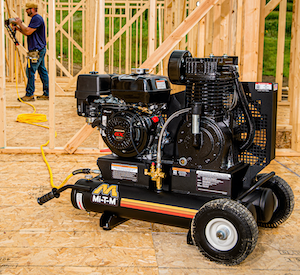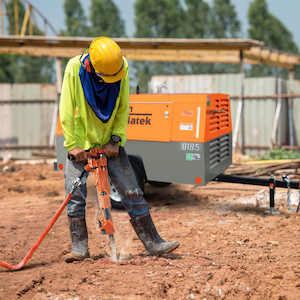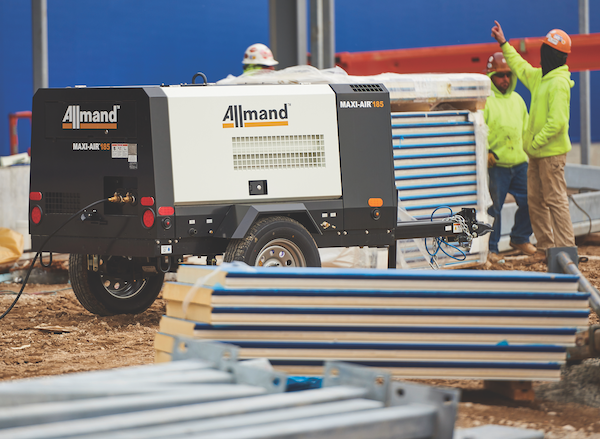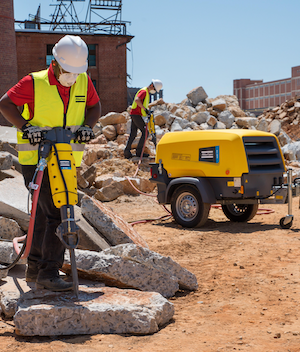Industry Outlook – Portable air compressors
Rental centers look for increased flexibility across new models.
|
|
|
Rental centers are requiring more service support due to the technological advances in equipment and engines.
|
|
|
|
The portable air compressor industry has come full circle. Single-tool compressors are gaining popularity because they are easier to move around, use less fuel and because they are under 25 horsepower, they do not fall under Tier 4 Final emissions criteria and can be powered by a smaller, simpler engine.
|
 |
| With advances in engine technology, it is now possible for air compressor manufacturers to use an engine with a smaller footprint to generate levels of horsepower that in the past would have required a larger, less efficient engine. |
 |
| Mi-T-M Wheelbarrow-style compressors are a good fit for building contractors. They are easy to transport, and new models are designed to last longer than previous units. |
As rental centers face higher acquisition costs for Tier 4 Final-compliant portable air compressors in the face of an inelastic rental rate, compressor manufacturers are developing units that can offer greater rental flexibility. Here’s where leading industry experts think this market segment is heading.
|
PAUL DALY |
ROI drives unit selection
Portable air compressors will always be used to power pneumatic tools. We are seeing an increase in the use of air compressors for fiber-optic cable blowing and natural-gas line blowouts. This current trend affects our customers’ needs in that they require more specialized knowledge of the application. So, they are looking to manufacturers to help educate them on these different applications.
They are also requiring more service support due to the technological advances in equipment and engines.Due to higher acquisition costs related to Tier 4 Final emission regulations, customers are focused on total cost of ownership to calculate ROI for new equipment purchases. They are sensitive to the long-term impact of costs related to maintenance and eliminating any downtime for equipment.
Allmand prides itself on supplying portable compressors that have the lowest total cost of ownership, along with the highest resale value. Allmand also employs experts in the field of compressed air and provides onsite technician training.
The most common concern rental centers have with compressor rentals is their current rental rates. Rental companies have been unable to raise rental rates on portable air compressors to keep up with the rising acquisition cost. Their ROI has been negatively impacted because of this situation. So, they have been forced to purchase air compressors with the lowest total cost of ownership that can also be sold at the highest resale value when they decide to dispose of the unit.
Due to advances in engines and technology, the rental market must continue to rely on manufacturers to help with service technician training. Rental company owners must also ensure their rental fleet is optimized for customer needs yet stay in compliance with any new regulations enacted by their local governing agencies, such as the California Air Resources Board (CARB). Allmand is invested in providing onsite training to maximize customers’ familiarity with our equipment, ensuring they can rent our products with full confidence.
 |
|
MATTHEW BENNETT |
Smaller units gaining interest
Our customers and sales reps report the more immediate trend in air compressors is a need for greater versatility. Specifically, they are looking for dual and high-pressure features and capabilities. They would like to have units in the general rental fleet that allow for varied settings and configurations for a broad range of applications aimed at growing utilization and deployment.
Looking at the current rental rates for most of the major United States markets, we have not seen a proportionate increase in rates to balance the ROI with the increased prices related to the new Tier 4 Final models. Manufacturers that can provide models that fit the core applications and those of a more tailored nature will likely pick up market share as we move forward in 2020 and the years to come. This is why Airman has introduced two Airman dual-pressure compressors in the past year, the PDS375S-6E1 and PDSG310S-6E1 models. The core considerations for what is purchased and why are the same as in the past: productivity, cost of ownership, longevity and resale value. But today, the biggest consideration is reconciling the required Tier 4 Final models into existing fleets.
 |
| Fuel efficiency and serviceability rank high with rental centers looking to replace portable air compressor models. |
These models have a significant increase in unit price, but rental centers do not see a proportionate increase in the rental rate coming anytime soon. Adding Tier 4 Final-compliant units into a fleet requires a few additional steps in their maintenance and use. Pre-delivery inspections and check-out/check-in processes will need to be updated as well. All of this has a direct impact on their ROI, and therefore directly impacts all considerations for fleet purchases.
Airman is committed to providing all markets with the most relevant products to meet the highest standards for quality, productivity and resale value. With the introduction of the PDS185S-6E1 in 2015, Airman was the first to offer the North American market a Tier 4 Final-compliant 185 cfm/100 psi portable compressor. The Airman product line continues to evolve though customer feedback and market demands. This evolution and commitment have resulted in the Airman PDS185S-6E1 that provides best-in-class fuel consumption, lowest noise level at 62 dBA and the lowest cost of ownership of any similar compressor on the market. ANA, Inc. is committed to be a trusted resource and partner, not just a supplier of goods.
The common needs or issues portable compressors have been the same as other construction-related equipment: product support! Service issues are a constant within the rental market. With the introduction of the new Tier 4 Final-compliant units, engine manufacturers have become an even more relevant part of the equation. The paramount issue with all customers is price and parts availability.
It’s never a matter of if the unit will break; it is just down to when. It does not really matter how well it works, if you cannot get a part for it when it breaks; it becomes an expensive boat anchor. For that reason, ANA, Inc. maintains a 90 percent-plus parts fill within 24 hours on all orders.
The decline of air tool deployment has affected compressor rentals. Today, most customers renting a 185 cfm compressor and only rent one tool if they rent a tool at all. So rental centers are adding 100 cfm models to their compressor fleets. The 100 cfm models are approximately $3,000 to $5,000 lower in price compared to a current model 185 cfm unit. While this would greatly improve the ROI, it will require some retraining of the end user to be confident pulling away with what they may see as a smaller unit than they are used to using.
 |
|
CLAYTON JONES |
Rental opportunities promise to grow
The top trends for rental centers are smaller footprints, latest technology in controls, and cost of ownership. Atlas Copco portable air experts have targeted these trends and therefore meet the needs in the market.
Some models have gone to a single axle and a reduced footprint. The Atlas Copco XC controller line is now one platform for ease of use as well as serviceability.
Lastly, we look at the overall cost including fuel consumption as well longer maintenance intervals. With the new controller that Atlas Copco uses, fuel consumption improves, and new air end technology has lengthened oil change intervals.
Cost of ownership is driving compressor selection. This includes the unit cost with service cost of a certain period.
Atlas Copco has gone through cost reduction exercises in its production processes, so these units remain competitively priced. Atlas Copco engineers have worked to extend service intervals on some models and created cost-effective service kits.
The most common issue rental centers face with portable air compressors is lack of training and product knowledge. This can lead to frustration when quality or functionality issues arise. New programs are now going on for virtual as well as hands-on training to educate customers on Atlas Copco’s latest technology.
With the current state of the economy and pandemic, portable air compressor activity has slowed to say the least. Once things rebound, infrastructure rebuild-repair-replacement will again become a big focus and the rental market will come back strong.
 |
|
ERIC MASSINON |
Compressor industry comes full circle
For the rental industry, the most recent trend is the reintroduction of the single-tool air compressors. For Chicago Pneumatic Power Technique, this is the CPS 110 KD air compressor. The 110 cfm compressors produce enough air to run a single 90-pound breaker all day and multiple other small tools.
Thirty years ago, compressor rental centers had fleets of single-tool compressors and two-tool compressors and larger compressors were added as needed. The industry changed in the late ’80s when the price of the two-tool compressors was less than a $1,000 the price of the single-tool compressors. The whole industry changed quickly with most rental companies standardizing on the two-tool 175 to 200 cfm compressors. Thirty years later with the price impacts of the new emissions regulations on the two-tool compressors, the price on the two tool compressors is $5,000 to$6,000 more than the single-tool compressors.
On top of that, the compressor industry has changed. Previously, rental users needed multiple compressors and breakers to remove concrete slabs, but skid steer loaders or excavators with large hydraulic attachments now remove the concrete, reducing the demand for jackhammers and compressors.
So, for more than 30 years, customers have been conditioned to ask for a 185 cfm compressor and whichever pneumatic tool they needed. The rental industry is now realizing that they’re sending out two-tool capacity compressors on rentals with only one tool. Rental fleets across the United States are seeing this as much as 80 to 90 percent of the time.
The single-tool compressors offer additional benefits. They are easier to move around, use less fuel and because they are under 25 horsepower. They do not fall under Tier 4 Final emissions criteria, so they can be powered with a simpler engine. Single-tool compressors do not need programmable controllers to operate the engines. Rather, they have simple on/off, hour meter and pressure gauge controls.
The portable air compressor industry has come full circle. The rental fleets now should offer both single-tool and two-tool diesel compressors. Rental rates need to be changed to correct the ROI on both sizes of these compressors to bring back a profitable ROI for the compressors.
Air compressor selection is driven by the same factors that drive any purchase within the rental fleet. What rentals are missed the most? What is the capital cost? What is the rate of return based on the expected utilization? When will it start making them money?
Chicago Pneumatic is designing more user-friendly compressors with features and benefits for rental. Additionally, it is offering the single-tool compressors with features that makes them easier to use.
Portable compressors for air tool operation only need to be set at 100 psi or less for the standard pneumatic handheld tools. In most cases, the tools are rated for 90 psi working pressure. Often, rental fleets adjust the compressors to operate well above the pressure recommended for the tools. Higher pressure doesn’t make the tools work better; it just increases the wear and tear on the compressor and the tools. Additionally, it causes the compressor to use more fuel than is needed.
Compressors should be set at the working pressure required for the tools being used. In general tool rental applications, higher working pressures are only needed with different types of media-blasting or for pressure-testing applications. Most standard single-tool and two-tool air compressors are not designed for the higher working pressures.
Rental centers can best serve their portable air compressor customers by making sure the compressor is sent out with proper safety equipment. They should have whip checks and safety clips for each hose connection, and they should always be used.
Operators should have hearing protection, eye protection, gloves and now dust collection systems as required. The air pressure should be set at the recommended working pressure for the tools or application. Whip hoses with line oilers should be used on tools and maintained.
Long-term rentals should be sent out with air tool oil and normal serviceable parts required by the tools. Finally, tool steel should be sharp and extra tool steel should be sent out with the tools.
 |
|
CODY BLYTHE |
Push for fuel efficiency, serviceability
Telematics/connected machines are a major trend in portable air compressors. Another major trend is the drive for greater efficiency. Customers want machines that consume less fuel. With advances in engine technology, it is now possible for air compressor manufacturers to use an engine with a smaller footprint to generate levels of horsepower that in the past would have required a larger, less efficient engine.
Aside from acquisition cost, machine serviceability and simplicity have become driving factors and Doosan Portable Power has focused its latest products on these two selection drivers. The ability to quickly service a machine and get it back in the fleet is essential. Doosan engineers are taking extra measures to ensure all daily and long-term maintenance items are easily accessible.
Machine downtime due to lack of customer education on Tier 4 technologies is a very common issue. It is very important to educate the customer on topics they may be unfamiliar with, like diesel exhaust fluid (DEF), aftertreatment systems and fuel quality.
Rental houses must frequently fix machines that have either had dirty fuel run through them or something other than DEF put in the DEF tank. These repairs can be costly, and most of the time they are easily avoidable by educating the customer upon machine delivery or pickup.
 |
|
ALEX SHIELDS |
Price and reliability drive compressor selection
As Tier 4 Final-compliant engines became mandated, air compressor manufacturers had to develop a communication system between the air compressor and the Engine Control Unit (ECU), which in turn, created a log of the engine’s operation.
Adding electronic controllers to control emissions had a side benefit of making variable pressure control more feasible. Most manufacturers now offer a compressor that can deliver variable pressure ranges.
The electronic controllers give rental houses more detailed machine information. For example, Kaeser’s Sigma Control Smart electronic control shows current operating and error codes as well as the air end temperature, coolant temperature, ambient temperature, operating pressures and emission regeneration data. It also allows the user to easily see the fuel level, battery voltage and discharge pressure.
Price and reliability continue to be the two biggest factors driving rental center purchasing decisions. Rental centers want to get the most from their purchase without compromising on the machine’s value and longevity. They need the compressors to be out in the field earning rent and not in the shop for service and maintenance.
Kaeser continues to find ways to make compressors more efficient and reliable with the quality customers have come to expect from the Kaeser name. From the advanced Sigma Control Smart electronic controller to the larger, slower-turning proprietary Sigma Profile air end and a patented anti-frost valve that guarantees the ideal operating temperature, Kaeser continues to improve compressor performance.
Unfortunately, compressors with advanced controls and the Tier 4 Final-compliant engines come at a higher price tag. To overcome this, rental companies are consolidating air compressor fleets. Some of the more popular units are now more versatile with variable pressure ranges and other features. One slightly more expensive and sophisticated model can handle what two or three compressor models did previously. This allows rental houses to take advantage of the advances of the newer units while purchasing and maintaining fewer units.
More advanced controls can mean more electronic problems. Compressors are used in harsh environments and it’s best to look for machines with good weatherproofing that protects controls, sensors and wiring.
Research with rental centers reveals that a common theme or trend they face is understanding the operation of sophisticated Tier 4 Final engines, including troubleshooting and diesel particulate filter regeneration.
Kaeser has taken numerous steps to assist contractors and equipment rental stores with the challenges associated with Tier 4 Final requirements. Kaeser’s Sigma Control Smart and Sigma Control Mobil controllers provide users with simple technology that offers diagnostics, maintenance monitoring and the ability to adjust pressure at the control panel.
Rental centers and end users struggle with the concept of regenerating the diesel particulate filter (DPF). Tier 4-compliant units need to run under load for passive regeneration of the DPF. If a Tier 4-compliant engine idles for extended periods, it prevents the machine from producing the heat required to burn off the trapped diesel particulate. When particulate matter builds up to 15 percent of the DPF capacity, the control panel alerts the user to run the machine at full load to induce regeneration. If particulate matter builds up to 80 percent, the machine will go into reduced power mode to prevent damage and will require service from an authorized OEM technician and may even have to come out of the field. Safeguards are built into the machine, but operators must be very vigilant when it comes to particulate buildup if they want to avoid downtime and work interruption. It is the Tier 4 machine’s Achilles heel.
Performing service at recommended intervals is critical to maintaining machine performance as well as extending economic useful life. When units come off rent, rental centers need to assess the condition of the machine. The good news is that the newer controls allow owners to know more about how the machine was operated while with the customer and determine what service is needed. Additionally, checking the soot level after each rental will indicate if regeneration must be performed before the next rental.
Kaeser and the other portable compressor manufacturers integrate engines from OEMs such as Kubota, John Deere, Caterpillar and others. The complexities of Tier 4 Final-complaint engines make it vital for the compressor owner to connect with the local authorized engine OEM service provider for support. Kaeser and other manufacturers can assist with troubleshooting, but the local engine service companies have the folks with the diagnostic tools, training and expertise to solve engine problems that may arise.
Looking at the outlook of the industry, 2020 was off to a great start with a robust and productive show season. Usually spring is the start of the busy season for compressor rental, but the industry acts like racehorses trapped at the starting gate. With the COVID-19 situation, demand is down for air compressors as well as other construction equipment. We continue to support our customers, and we are hopeful for the second half of the year.
 |
|
MATT HOEFER |
Growing demand for smaller units
Trends in the rental industry have influenced the demand for affordable, high-quality air compressors, and Mi-T-M manufactures a wide variety for the do-it-yourselfer and professional contractor.
Mi-T-M recently introduced a 3-gallon air compressor to its Work Pro Series. This unit features an oil-free pump and can power everything from brad staplers to nail guns. Because of its quiet technology, it can be used indoors where there may be noise restrictions. At only 51 pounds, this little machine puts out 4.0 cfm at 90 psi. Mi-T-M has recognized the advances in oil-free compressors and is considering adding more models to its product line.
Contractors love the portability of the wheelbarrow-style air compressors and Mi-T-M’s 8-gallon model has always been popular in the rental industry because of its ability to power everything from small nail guns up to impact wrenches. Recently updated with a redesigned compressor head and piston valve, rental centers will appreciate the longer operating life it offers. A new textured black powder-coat paint resists wear and gives the unit more of an industrial appearance.
Construction professionals demand products that maximize production and the Mi-T-M rotary screw air compressor does just that, making it a perfect fit for the rental industry. Based on customer requests, Mi-T-M updated the design of the drive system from a poly chain to a more efficient V-belt system. A simple frame change and a new muffler reduces noise output; it also features a textured powder-coat paint for a more industrial look.
 |
|
RUS WARNER |
Increasing move to rental units
We’ve seen a couple of major trends taking place, and with the market uncertainty following the pandemic, we only expect these to accelerate.
Customers are demanding increased flexibility from portable air compressors so they can cover a range of applications with a single unit. The added flexibility allows contractors to cover more jobs using fewer assets. It also helps drive improved ROI for rental companies through increased utilization and a consolidated fleet.
This is driving manufacturers like Sullair to develop machines that produce a range of flow and pressure, such as the new Sullair 800HH-=>900H. It allows the operator to choose whatever pressure they need between 100 and 200 psi. The compressor will automatically adjust to produce the maximum cfm available at that level. This has also been incorporated into the Sullair 375 Series where the machine shifts from low to high pressure by flipping a switch.
There is also an increasing trend to rent vs. buy. Compressor customers appreciate the value brought by partnering with a rental company. Given the difficulty of hiring and retaining qualified service technicians, many contractors are looking to get out of the repair business. By renting, customers transfer all maintenance and repair work back to the rental company. This streamlines their business while ensuring a well-maintained compressor is only a phone call away.
Further, by renting, customers are transforming equipment capital from a fixed cost to a variable cost and only paying for what they need while reducing overhead expenses such as salaries and shop costs. An added benefit is additional cost savings on storage and logistics. When renting, contractors no longer need to worry about storing idle equipment or transporting it long distances to job sites.
One of the greatest influences on a rental company’s purchasing decision is serviceability. Rental customers look at the overall, end-to-end experience. The focus on serviceability is a primary driver in how Sullair designs its new compressors. It incorporates features for enhanced access and serviceability. For example, some units having access doors on all four sides; and for safety, a battery cutoff switch.
Because of the many regions and local preferences across North America, a range of engine options is needed to ensure there is always strong local support. This is one of the reasons Sullair announced its new line of Perkins-powered equipment at the 2020 ARA Show. We continuously assess our compressor line to ensure we have several engine options available to meet customer needs.
Like generators, air compressors are a portable power source used for hundreds of applications. When a customer walks through the door of a rental company, they know they need a compressor but often need help sizing a compressor. This is where an experienced and well-trained rental staff adds tremendous value. By knowing what questions to ask, the rental company can provide the best compressor for a customer. In turn, the rental companies rely on the manufacturer’s field sales force to provide the necessary training and information. An experienced salesperson who is dedicated to supporting the rental industry is one of the best resources a company can have, and this is the reason Sullair works hard to ensure its sales team stays up-to-date on market changes and trends.
The conversion to Tier 4 Final emissions requirements was costly for rental companies. Rental rates have not remained on par with the acquisition costs. To maximize ROI, many rental companies are mixing their fleets with new and factory-authorized remanufactured compressors. Remanufactured compressors help rental companies expand their fleet affordably and maintain competitive rental rates in the market.
 |
|
DAVID RAFFIN |
Customers appreciate personal support
There is a trend on a major focus in fuel efficiency and serviceability for portable compressors. With the initial sticker shock phase of Tier 4 Final-compliant engines mostly behind us, it really comes down to the overall cost of ownership and the ease of maintenance. The lower operating costs of the newer portable compressors has helped large national rental chains and small rental houses alike, helping save valuable capital in a time of such uncertainty.
While price has and always will be a major factor, parts availability and service are major factors in the decision-making process. Being a United States-owned and -operated company, Sullivan Palatek’s ability to respond to customers’ parts requests swiftly and being able to handle service calls effectively has always been a strong point Those who have worked with Sullivan Palatek know that when they call into the factory, they talk to a real service tech and won’t get bounced around an automated phone system. Human interaction is something that offers a ton of value, especially when there is a compressor down.
This originally appeared in the July-August 2020 issue of Pro Contractor Rentals magazine. ©2020 Urbain Communications LLC. All rights reserved.











